Menu
Physics Lesson 9.5.2 - Buoyant Force
Please provide a rating, it takes seconds and helps us to keep this resource free for all to use
Welcome to our Physics lesson on Buoyant Force, this is the second lesson of our suite of physics lessons covering the topic of Buoyancy. Archimedes' Principle, you can find links to the other lessons within this tutorial and access additional physics learning resources below this lesson.
Buoyant Force
The resistive effect caused by the fluid we mentioned above, causes a resistive force, which we call "buoyant force". In other words, buoyant force is the upward force exerted by a fluid on an object that is completely or partially immersed in it.
Buoyant force is symbolically expressed as Fb and like all the other forces, it is measured in Newton.
Since the direction of buoyant force is vertically upwards, the equation for the resultant vertical force acting on an object immersed in a fluid is
where Fg is the gravitational force acting on the object. Look at the figure.
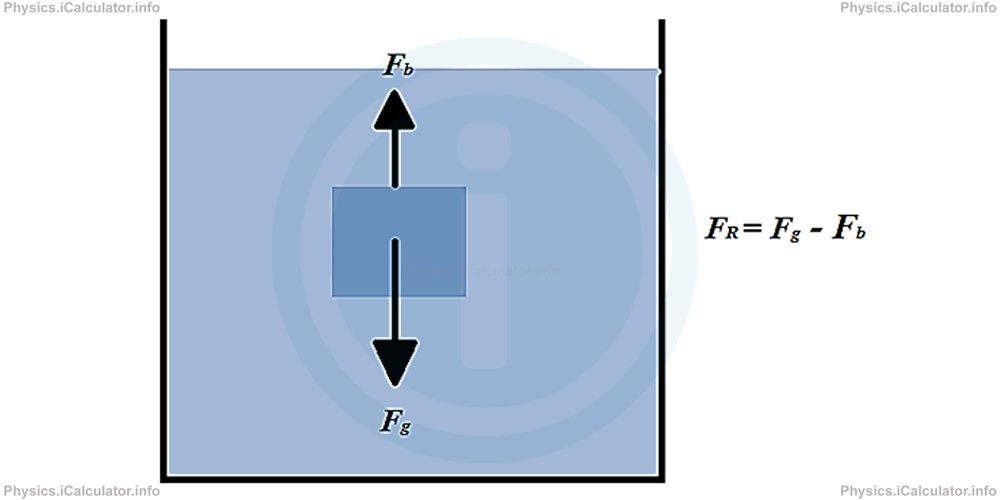
There are three possible cases of an object immersed in a fluid:
1- The object is not at rest because Fg > Fb and therefore, FR = Fg - Fb > 0. As a result, the object is falling down (sinking).
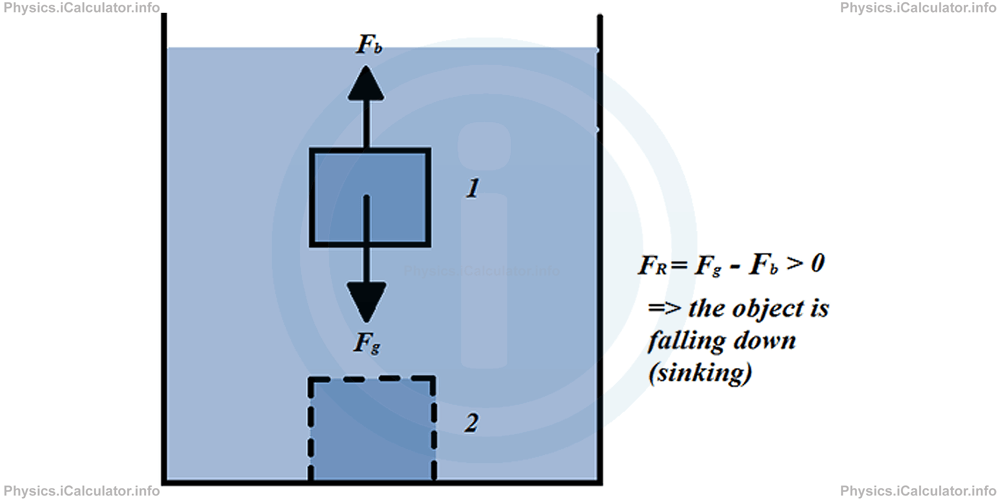
2- When buoyant force is numerically equal to the gravitational force, we have
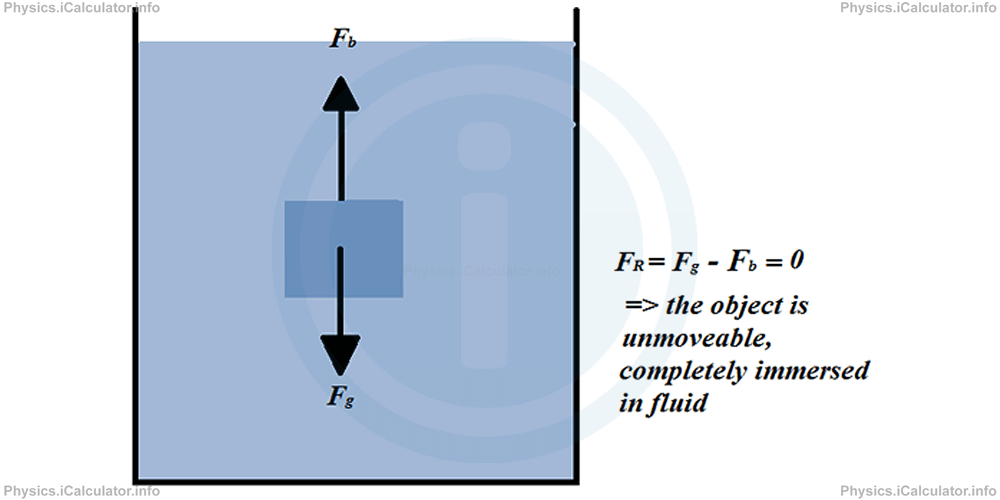
3- When buoyant force is numerically greater than gravitational force (when we force an object to stay immersed in fluid), initially we have
As a result, when released the object raises up, until a part of it is pushed out of fluid. This is why air bubbles rise in water until they go to the water surface and "explode", i.e. they move to the air. In floating objects, the equilibrium of forces is re-established when they go to the liquid surface and then objects float at rest on liquids as shown in the figure below.
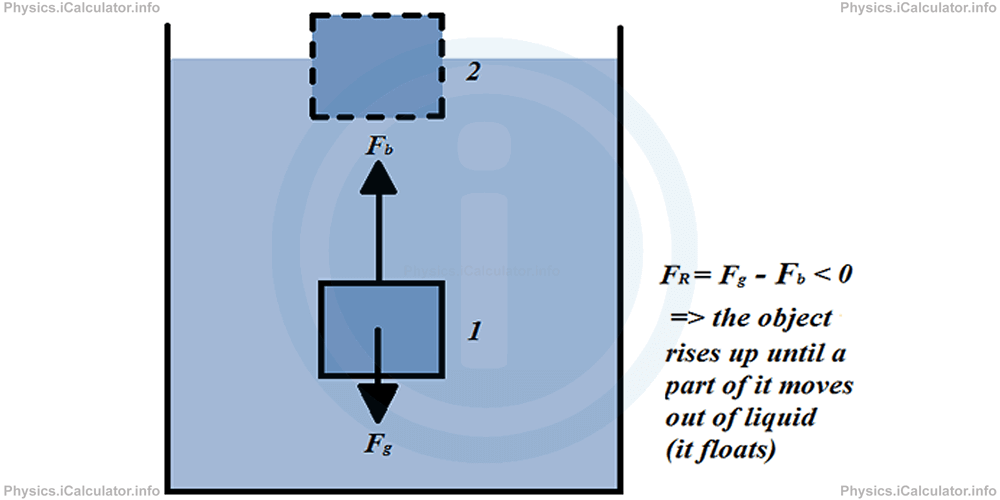
When the equilibrium is established, we have
Or
Let's use the above explanation to obtain a formula for the buoyant force Fb. From experience, we know that heavy objects such as metals, stones, etc., sink when immersed in water (case 1). This is because they have a greater density than water (i.e. the medium). On the other hand, light objects such as wood, polystyrene, etc., float on water (case 3). This is because their density is smaller than the density of water.
When objects have a density close to the density of water, they usually stay completely immersed in water, neither sinking nor floating (case 2). As an example, we can mention the human body. It is known that about 70% of the human body is made by water. The rest are mostly ashes, flesh and air, whose average density is close to the density of water (1000 kg/m3) as well. Therefore, when we hold our breath, we float on water as the extra air we have on our lungs reduces the density of our body, making it slightly smaller than the density of water. On the other hand, when we release the breath from our lungs, the density of body increases becoming temporarily slightly greater than the density of water. As a result, we sink. In normal condition, we stay completely immersed in water (divers for example). This is because the density of our body is very close to that of water.
Said this, we can use the help of the second case (object completely immersed in liquid) to derive a formula for the buoyant force. As stated above, in this case, we have
or (numerically):
Since
= ρobj × Vobj × g
we obtain after substitutions,
Since in the second case ρobject = ρliquid, we obtain for the buoyant force Fb:
The same formula is used for the other two cases as well. The only thing to keep in mind is that in the third case (in floating objects), we must consider only the part of object's volume immersed in liquid because (as discussed earlier) the new buoyant force is smaller than the original one, when the object was forced to stay completely immersed in liquid. Thus, the new (reduced) buoyant force is auto-regulated to equal the force of gravity by sending out of liquid the unnecessary part of the volume. As in the other two cases the total volume of the object complies with that of the immersed part, we can generalize as
The above formula is the standard formula of buoyant force.
Now, it is understandable why we can learn more easily swimming in seawater than in lake water. As the density of seawater is greater than that of lake water, the buoyant force in seawater (salty water) is greater than the buoyant force in lake (sweet or pure) water. This helps keep us floating on water.
Example 1
An object, which normally weighs 45 N (figure a), is hanged on a spring balance and then immersed in water. Now, the spring balance shown the value 30 N (figure b). What is the density of the object? Take g ≈ 10 m/s2 and ρwater = 1000 kg/m3.
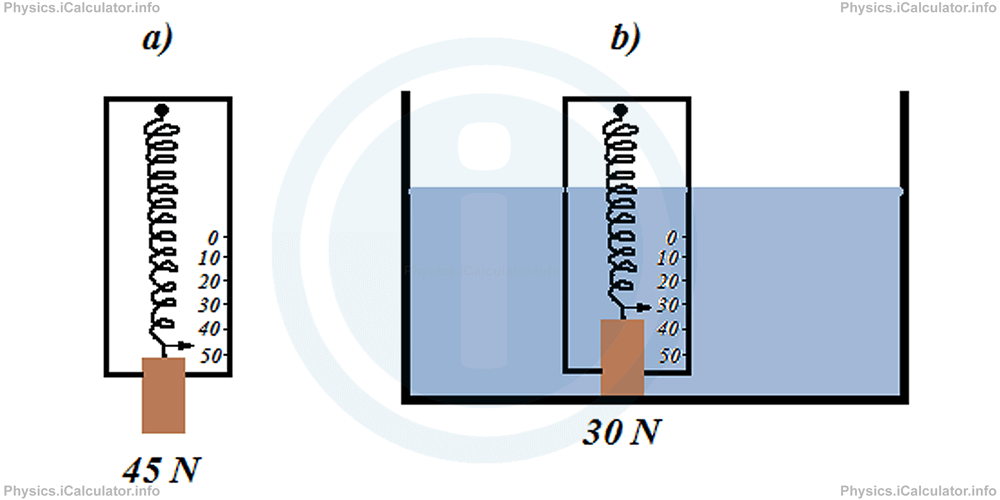
Solution 1
From the first figure, we can find the mass of object. We have:
⇒ mobj = W/g
= 45 N/10 m/s2
= 4.5 kg
The buoyant force exerted by the water is obtained by calculating the difference between the two readings of spring balance. Thus,
= 45 N - 30 N
= 15 N
This result helps in calculating the volume of object through the other formula of buoyant force, i.e. from the formula
we can individualize the volume of the immersed part of object which corresponds to its total volume. Thus,
= Fb/ρliq × g
= 30 N/1000 kg/m3 × 10 m/s2
= 0.003 m3
Therefore, the object's density is
= 4.5 kg/0.003 m3
= 1500 kg/m3
You have reached the end of Physics lesson 9.5.2 Buoyant Force. There are 4 lessons in this physics tutorial covering Buoyancy. Archimedes' Principle, you can access all the lessons from this tutorial below.
More Buoyancy. Archimedes' Principle Lessons and Learning Resources
Whats next?
Enjoy the "Buoyant Force" physics lesson? People who liked the "Buoyancy. Archimedes' Principle lesson found the following resources useful:
- Force Feedback. Helps other - Leave a rating for this force (see below)
- Density and Pressure Physics tutorial: Buoyancy. Archimedes' Principle. Read the Buoyancy. Archimedes' Principle physics tutorial and build your physics knowledge of Density and Pressure
- Density and Pressure Revision Notes: Buoyancy. Archimedes' Principle. Print the notes so you can revise the key points covered in the physics tutorial for Buoyancy. Archimedes' Principle
- Density and Pressure Practice Questions: Buoyancy. Archimedes' Principle. Test and improve your knowledge of Buoyancy. Archimedes' Principle with example questins and answers
- Check your calculations for Density and Pressure questions with our excellent Density and Pressure calculators which contain full equations and calculations clearly displayed line by line. See the Density and Pressure Calculators by iCalculator™ below.
- Continuing learning density and pressure - read our next physics tutorial: Bernoulli Equation
Help others Learning Physics just like you
Please provide a rating, it takes seconds and helps us to keep this resource free for all to use
We hope you found this Physics lesson "Buoyancy. Archimedes' Principle" useful. If you did it would be great if you could spare the time to rate this physics lesson (simply click on the number of stars that match your assessment of this physics learning aide) and/or share on social media, this helps us identify popular tutorials and calculators and expand our free learning resources to support our users around the world have free access to expand their knowledge of physics and other disciplines.